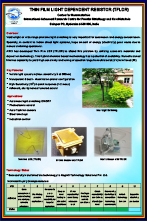Centre for Technology Acquisition and Transfer (CTAT)
Super hydrophobic easy to clean coating for self-cleaning of PV panels and other applications
Readiness Level:
IPDI Level: 9 (Initiated Technology Transfer)
Key Features:
- 1. Low cost production (simple coating technique / easy scalable / curable by ambient temp.)
- 2. Highly transparent coating (no loss in transmittance / power conversion efficiency after deposition)
- 3. Super hydrophobic property: > 1100 water contact angle
- 4. High weather stability (withstand long duration accelerated test (IEC 61646)
- 5. High mechanical stability
- 6. Low dust deposition compared to bare and other commercial coated samples
Possible Applications:
- 1. Solar PV & CSP cover glass
- 2. Optical lenses
- 3. Video display panels
- 4. Architectural glasses
* Last updated on April 2021
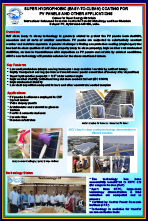
Cost-efficient solar receiver tube technology for low & medium temperature solar thermal applications
Readiness Level:
IPDI Level: 9 (Initiated Technology Transfer)
Key Features:
- 1. High selective properties (Solar Abs ~95%; Spectral emittance ~0.12)
- 2. Low heat loss property: ~0.14 at 3000C
- 3. Temperature stability: < 3000C
- 4. Corrosion stability: > 200 hrs withstand in salt spray test
- 5. High mechanical stability, Long durability and highly enhanced weather protection
Possible Applications:
- 1. Solar water heater /Solar dryer
- 2. Solar desalination
- 3. Stream generation for various industrial applications
- 4. ORC solar collector based power generation
* Last updated on April 2021
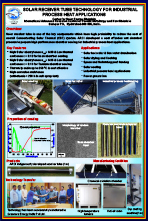
Synthesis of electro-catalyst for use in fuel cells
Readiness Level:
IPDI Level: 9 (Initiated Technology Transfer)
Key Features:
- 1. Pt based electrocatalysts can be prepared using an easily scalable method
- 2. The electrocatalysts enables unique performance and better durability for fuel cell reactions (ORR, HOR)
- 3. Tuneable particle size and surface area of electrocatalysts produced
- 4. Better catalyst utilization and higher electro-catalytic activity
- 5. The substrate material is functionalized to hold the Pt particles stronger. So both strength and durability is increased.
Possible Applications:
- 1. Fuel cells
* Last updated on April 2021
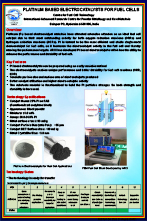
Lead free copper alloys for bimetallic bearings
Readiness Level:
IPDI Level: 9 (Initiated Technology Transfer)
Key Features:
- 1. Make-in-India
- 2. Elimination of lead as per B-4 emission norms
- 3. Yield Strength: 450 MPa (BMC840), 470 MPa (BMC841)
- 4. Hardness: 119 HVN (BMC840), 127 HVN (BMC841)
- 5. Wear Resistance: 18μm/h
- 6. Fatigue Strength: 110 Mpa
Possible Applications:
- 1. Main bearings and connecting rod bearings for heavy duty vehicles
- 2. Cars and motor cycle bearings
- 3. Transmission and hydraulic pump bushings
- 4. Wear plates
- 5. Fuel cells
- 6. Camshaft bushings for medium size vehicles
* Last updated on April 2021
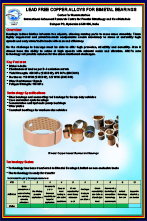
Advanced detonation spray coating technology
Readiness Level:
IPDI Level: 8 (Reassessing feasibility (IP, Competition, Technology, Commercial))
Key Features:
- 1. High productivity due to high pulse frequency
- 2. Less maintenance: absence of mechanically moving parts
- 3. Good adhesion strength (>10000 psi)
- 4. Dense microstructure (< 1%)
- 5. Negligible thermal degradation and excellent tribological properties
- 6. Ability to coat wide range of powders, carbide, oxide, metal powders
- 7. Lower substrate temperature & low oxide content
- 8. Coatings with 50-2000 microns thickness can be produced
Possible Applications:
- 1. Steel industry application such as Bridle rolls
- 2. Textile & Paper industry applications such as wire passing pulleys, plungers, steeped cone pulleys, bearing stopper plates, guide rolls
- 3. Gas compressor applications such as spindle valve, compressor disc, compressor shaft
- 4. HP & LP turbine blades, compressor discs, LCA nozzles, thrust beating sleeves, propeller shaft seals.
- 5. Power and Energy applications such as guide vanes, spindle valves, hydro turbine blades.
* Last updated on April 2021
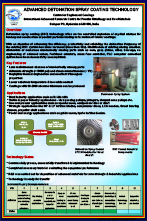
Micro arc oxidation coating technology
Readiness Level:
IPDI Level: 8 {Reassessing feasibility (IP, Competition, Technology, Commercial)}
Key Features:
- 1. Ability to coat Al, Ti, Mg and Zr metals and their alloys
- 2. Ease to coat complex shapes and also regions difficult to access
- 3. Uniform, dense, hard and thick coatings
- 4. Superior coating properties and performance compared to other conventional acid based processes like anodizing and hard anodizing
- 5. Excellent tribological properties and corrosion resistance
- 6. Eco friendly
- 7. 5-40 times service life improvement
Possible Applications:
- 1. For a wide array of applications in industry sectors such as textile, automobile etc.
* Last updated on April 2021
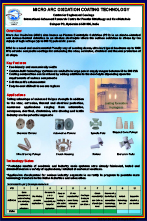
Indigenous Electrode Material, Lithium Iron Phosphate LFP for EV Applications
Readiness Level:
IPDI Level: 7 (Checking Repeatability/ Consistency at Prototype Level)
Key Features:
- 1. Identified sources of cost-effective lithium and iron precursors
- 2. The processing cost of 1 Kg of LFP is Rs. 3144 developed at ARCI.
- 3. Cost can be reduced by 20% by designing suitable cost-effective large capacity furnace and optimum heating cycles with less time
- 4. ARCI developed LFP’s electrochemical performance in terms of specific capacity; cyclic stability and rate capability is at par with the performance of the commercially available LFP
- 5. Considering the existing facilities for LFP the batch size is 29 kgs per day is being produced.
Possible Applications:
- 1. LiB batteries used in electric vehicle applications
* Last updated on April 2021
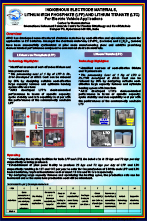
Indigenous Electrode Material, Lithium Titanate LTO for EV Applications
Readiness Level:
IPDI Level: 7 (Checking Repeatability/ Consistency at Prototype Level)
Key Features:
- 1. Identified sources of cost-effective lithium and Ti precursors
- 2. The processing Cost of 1 Kg of LTO is Rs.1700 developed at ARCI. Cost can be reduced by 20% by designing suitable cost-effective large capacity furnace and optimum heating cycles with less time
- 3. ARCI developed LTO’s electrochemical performance in terms of specific capacity; cyclic stability and rate capability is at par with the performance of the commercially available LTO
- 4. Considering the existing facilities for LTO, the batch size of 72 kgs per day is being produced
Possible Applications:
- 1. LiB batteries used in electric vehicle applications
* Last updated on April 2021

Pyrotechnic grade Zr powder
Readiness Level:
IPDI Level: 7 (Checking Repeatability/ Consistency at Prototype Level)
Key Features:
- 1. Simple Hydrating and dehydrating route
- 2. Conversion of Zr sponge to powder
Possible Applications:
- 1. Thermal batteries
* Last updated on March 04, 2021
Cathodic Arc PVD deposition of wear resistant coatings on compressor blades/vanes & dies
Readiness Level:
IPDI Level: 7 (Checking Repeatability/ Consistency at Prototype Level)
Key Features:
- 1. Films/coatings of different structures with good control over chemistry and thickness can be developed: (i). Mono-layer, (ii) Multi-layer, (iii) Gradient and (iv) Functionally multi-layered/graded
- 2. Films/coatings containing Ti, Cr, AlSi & AlTi can be coated in pure metallic or nitride or carbide form. i.e. TiN, CrN, TiAlN, TiAlSiN, CrAlSiN, TiCrAlSiN, TiC, TiCN, TiAlCN, etc.
- 3. Physical and mechanical properties can be tuned by varying deposition conditions
- 4. Environmentally green and easily up scalable process with high production rates
Possible Applications:
- 1. Aerospace components
- 2. Hard and wear resistant coatings for cutting tools – up to hardness of 45 GPa
- 3. Wear resistant coatings for dies, bearings, etc. – Low friction coefficient of < 0.2
- 4. Erosion resistant coatings for compressor blades – A thickness of 20 μm is achieved
- 5. Solar selective coatings for solar thermal applications – ~ α: 0.96 & ε: 0.09 at 400°C
- 6. Diffusion barrier coatings for electronic components
- 7. Decorative coatings for aesthetic applications, etc.
* Last updated on April 2021

Cold gas dynamic spray technology
Readiness Level:
IPDI Level: 7 (Checking Repeatability/ Consistency at Prototype Level)
Key Features:
- 1. Indigenously developed state of the art PLC based automated Portable control panel (Max Pressure – 20 bar)
- 2. Different set of nozzles
- 3. High deposition rate or coverage area
- 4. Low deposition rate or coverage area
- 5. For Ni based materials, Steels
- 6. Compressed AIR as process and carrier gas
- 7. Maximum Pressure- 20 bar; Maximum Temperature-600oC
- 8. Cu, Al, Ag, Zn, Sn,Ni, SS, Ta, Nb, Ti and alloys and composites
Possible Applications:
- 1. Repair and Refurbishment Applications
- 2. Coatings for Electrical contacts, lugs, EMI shielding, heat sinks
- 3. Coatings for High Temp Corrosion resistance, Bio medical, Sputter Target
- 4. Cathodic Protection coatings
- 5. Anodic Protection coatings
- 6. Wear resistant coatings
- 7. Nanostrcutured / amorpohous coatings
- 8. High Entropy Alloy Coatings for High Temperature Applications
* Last updated on April 2021

Sintered silicon carbide SiC components
Readiness Level:
IPDI Level: 7 (Checking Repeatability/ Consistency at Prototype Level)
Key Features:
- 1. Tunable density and other thermo-mechanical properties.
- 2. Flexibility in producing SiC parts incorporating solid-state or liquid phase sintering additives.
- 3. Capable to produce SiC components up to 750 mm diameter.
- 4. Critical SiC parts can be manufactured.
Possible Applications:
- 1. Mechanical seals particularly for corrosive environment.
- 2. Impact and abrasion resistance parts.
- 3. Light-weight structural parts for aerospace applications.
- 4. Impact and wear resistant parts.
* Last updated on April 2021
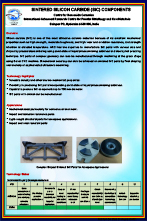
High temperature ceramic sealants
Readiness Level:
In refractory castables and high temperature applications
Key Features:
- 1.In refractory castables and high temperature applications
Possible Applications:
- 1. Aimed at developing two types of cements, namely high alumina cement (with 71% alumina content) and low alumina cement (with 51% alumina content)
- 2. Process parameters were optimized to achieve the desired phases.Process parameters were optimized to achieve the desired phases.
- 3. Found to be acceptable beyond 900oC.
* Last updated on April 2021
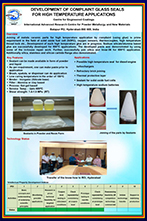
Repair of helicopter pinion housing
Readiness Level:
IPDI Level: 7 (Checking Repeatability/ Consistency at Prototype Level)
Key Features:
- 1. Repair is possible without preheating of the components/tools
- 2. Low heat input to the component, so less damage
- 3. Narrow soft zone created with relatively high hardness
- 4. Fully automated and repeatable
- 5. Precise deposition and less post processing
Possible Applications:
- 1. Repair and refurbishment of aerospace components
* Last updated on April 2021
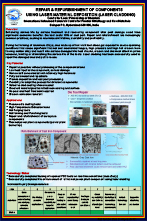
Power plant burner tip cladding
Readiness Level:
IPDI Level: 7 (Checking Repeatability/ Consistency at Prototype Level)
Key Features:
- 1. Highly controlled process
- 2. Flexibility to adopt the process for different components
- 3. Selective clad coating where needed
- 4. Excellent metallurgical bond between coating and surface
- 5. No post clad heat treatment required
- 6. Erosion corrosion resistant
Possible Applications:
- 1. Thermal power plant components (power plant burner tip)
* Last updated on April 2021
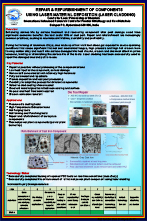
Dual functional anti-fogging and antireflective coatings for optical, solar and display applications
Readiness Level:
IPDI Level: 6 (Prototype testing in real-time conditions)
Key Features:
- 1. High transmittances in visible and solar regions: >98 % (in visible) >96% (in solar)
- 2. Low temperature curable (80-1000C)
- 3. High temperature stability: Max up to 10000C
- 4. Weather stability: > 200hrs withstand in high humidity (>90%) at 500C
- 5. High mechanical stability and Long durability
- 6. Coat effective coating technique
Possible Applications:
- 1. Solar PV & CSP cover glass
- 2. Optical lenses
- 3. Video display panels
- 4. Architectural glasses
- 5. High power lasers
* Last updated on March 04, 2021
Membrane electrode assembly MEA for PEM Fuel Cell
Readiness Level:
IPDI Level: 6 (Prototype testing in real-time conditions)
Key Features:
- 1. Core component for PEM fuel cell
- 2. Capability for making larger area (upto 770 sq.cm) MEA for fuel cell
- 3. Seven-layer assembly
- 4. Better fuel cell performance can be obtained in single cell/stack level.
Possible Applications:
- 1. Fuel cell applications
* Last updated on March 04, 2021
Control system for transport application
Readiness Level:
IPDI Level: 6 (Prototype testing in real-time conditions)
Key Features:
- 1. Better fuel cell operating parameters monitoring
- 2. Quick response
- 3. Load following gas flow controllers
Possible Applications:
- 1. Fuel cell applications
* Last updated on March 04, 2021
Power conditioner DC
Readiness Level:
IPDI Level: 6 (Prototype testing in real-time conditions)
Key Features:
- 1. Higher converter/inverter efficiency
- 2. Wider voltage/current window for inverter/converter.
- 3. Unitized DC output in a system
Possible Applications:
- 1. Fuel cell applications
- 2. Used in power generation/distribution applications
* Last updated on March 04, 2021
Power conditioner AC
Readiness Level:
IPDI Level: 6 (Prototype testing in real-time conditions)
Key Features:
- 1. Higher converter/inverter efficiency
- 2. Wider voltage/current window for inverter/converter.
- 3. Unitized AC output in a system
Possible Applications:
- 1. Fuel cell applications
- 2. Used in power generation/distribution applications
* Last updated on March 04, 2021
Electrolyzer for MEA
Readiness Level:
IPDI Level: 6 (Prototype testing in real-time conditions)
Key Features:
- 1. Core component for PEM based electrolyzer for hydrogen production
- 2. Capability for making larger area (upto 770 sq.cm) MEA for electrolyzer
- 3. Seven-layer assembly
- 4. Better hydrogen production performance can be obtained in single cell/stack level
Possible Applications:
- 1. Fuel cell applications
* Last updated on March 04, 2021
PEM Nafion based composite
Readiness Level:
IPDI Level: 6 (Prototype testing in real-time conditions)
Key Features:
- 1. Alternative to commercial Nafion membrane
- 2. Low ionomer content and cost
- 3. Equivalent fuel cell/electrolyzer performance compared to commercial Nafion
- 4. Impermeable to reactant gases
Possible Applications:
- 1. Fuel cell applications
* Last updated on March 04, 2021
Membrane humidifier
Readiness Level:
IPDI Level: 6 (Prototype testing in real-time conditions)
Key Features:
- 1. Better design for humidifying reactant gases for fuel cell
- 2. Easily scalable for fuel cell capacity ranging from 0.5 kW to 10 kW
- 3. Controllable dew point/humidification step
Possible Applications:
- 1. Fuel cell applications
* Last updated on March 04, 2021
Bottle humidifier
Readiness Level:
IPDI Level: 6 (Prototype testing in real-time conditions)
Key Features:
- 1. Better design for humidifying reactant gases for fuel cell
- 2. Easily scalable for fuel cell capacity ranging from 0.5 kW to 10 kW
- 3. Controllable dew point/humidification step
Possible Applications:
- 1. Fuel cell applications
* Last updated on March 04, 2021
MEA for Electrolyzer
Readiness Level:
IPDI Level: 6 (Prototype testing in real-time conditions)
Key Features:
- 1. Core component for PEM fuel cell with excellent design
- 2. Better fuel cell performance can be obtained in single cell/stack level.
Possible Applications:
- Fuel cell applications
* Last updated on March 04, 2021
Fe-P soft magnetic material for alternators
Readiness Level:
IPDI Level: 5 (Checked repeatability/consistency at coupon level)
Key Features:
- 1. Industrially viable wrought metallurgy process
- 2. Alloy produced from low cost raw materials (cost effectiveness)
- 3. Better mechanical properties advantages of machinability
- 4. Good magnetic properties equivalent/better than commercial materials
Possible Applications:
- 1. Used in alternators of automobiles
- 2. Used in manufacture of various motors used in automobiles
- 3. Explored for applications involving magnetic switching in valves and switch gears.
* Last updated on March 04, 2021
Strontium ferrite hard magnetic material for bonded magnets
Readiness Level:
IPDI Level: 5 (Checked repeatability/consistency at coupon level)
Key Features:
- 1. Produced from low cost raw materials
- 2. Better mechanical properties
- 3. Ease of machinability
- 4. Good magnetic properties equivalent/better than commercial materials
Possible Applications:
- 1. Used in alternators of automobiles
- 2. Used in manufacture of various motors used in automobiles
* Last updated on March 04, 2021




